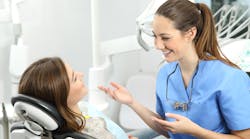Dental procedure coding happens when dental professionals charge out procedures to their patient’s itemized ledger during the dental appointment. By charging a patient’s insurance with a current dental terminology (CDT) code, two things happen: it shows which procedures are more commonly occurring, and it helps determine the total cost of a particular dental appointment based on how many procedures occurred at the time of the appointment.1
Just because a patient has insurance doesn’t mean that any of the procedure codes will be covered. Sometimes dental professionals charge out a dental procedure code, but they won’t actually place a cost for that code toward the patient’s care. The dental team needs to be as informed as possible about dental codes because they may be revised or deleted annually.2 New procedure codes are drafted each year as well.
CDT code for oral hygiene instruction
One of the newer CDT codes generated in the last decade is the code we use to give oral hygiene instruction (OHI) to our patients. CDT code D1330 came about in 2015.3 This code currently reads, “this may include instructions for home care; such as tooth brushing technique, flossing, and use of special oral hygiene aids.”2
Most dental insurance companies don’t reimburse for this code; they suggest that dental providers charge out directly to any procedure they complete during treatment.2 We give OHI to patients throughout their appointment in hopes that they will be able to take care of their own oral health at home. OHI can be performed at limited evaluations or at regular recare checkups and periodontal maintenance appointments.4
You may also be interested in ... New year, new ADA CDT codes
Oral hygiene instructions and the dental appointment
OHI occurs when dental providers ask questions about how their patients are currently caring for their dentition and their oral cavity.4 We actively listen as patients describe their typical oral care routine at home.4 Based on what patients tell us, we can then guide them by sharing detailed instructions and suggestions on how to make their care more effective. Some dental providers make lists or give patients printed examples of items they can use to tailor their home-care regimen. Other times, there are hands-on activities we can give patients to help them grasp the mechanisms of the OHI.
Current research shows that patients respond more openly to OHI when dental providers take time to actively listen and motivate them based on their behavioral responses in that interview.5 Another research study found that technology has become an increasingly popular way to deliver OHI to patients.6
Because OHI is particularly important for pediatric patients, some physicians even charge out CDT code D1330. It should be noted that medical providers typically work with current procedure terminology (or a CPT code), but they can charge out CDT codes as applicable. Physicians and pediatricians believe that establishing a good oral home-care regimen is part of a healthy childhood, so when they ask about it during well-visit checkups, they charge out the CDT code.3
Getting patients to recognize the importance of OHI
OHI happens every day with hundreds of patients, but do oral health providers and insurance companies recognize the CDT code? Each dental and medical office must decide if they are going to charge out the CDT code D1330; they don’t necessarily have to have an actual office fee applied with it. Dental practices can help patients recognize the importance of OHI by listing the procedure code on their itemized ledger as a zero-fee schedule. The code can be shown as a professional courtesy to patients since it’s often not covered by insurance and many oral providers struggle to put an actual price on OHI.
In the future, it would be interesting to know how many oral care professionals and medical providers are already using D1330. A research project could determine how many dental providers are unaware of the D1330 code even though it has been around for quite a while.
If dental professionals and medical providers collaborated on more effective OHI, motivational interviewing or various methods of technology might become available. We need more continuing education courses that discuss the use of CDT codes and their annual updates. Perhaps if more health professionals (both medical and dental) use the OHI CDT code more regularly, it will begin to be reimbursed by insurance.
Also by the author ...
- Holistic dentistry: What to know about natural dental home-care products
- Chlorhexidine mouthwash: Still the best choice for dental patients?
- Tonsils and the intraoral dental exam: What to look for
Editor’s note: This article first appeared in Through the Loupes newsletter, a publication of the Endeavor Business Media Dental Group. Read more articles and subscribe to Through the Loupes.
References
- Collins J. New 2021 CDT codes for the New Year. DentistryIQ. January 1, 2021. Accessed October 15, 2023. https://www.rdhmag.com/patient-care/article/14187767/new-2021-dental-cdt-codes-for-the-new-year
- Blair C. Coding with Confidence: The “Go To” Dental Coding Guide. CDT 2022 Edition. eAssist Publishing; 2022.
- Oral health coding fact sheet for primary care physicians. American Academy of Pediatricians. 2022. Accessed October 11, 2023. https://downloads.aap.org/AAP/PDF/coding_factsheet_oral_health.pdf
- What is good oral hygiene? Colgate-Palmolive. Updated January 9, 2023. Accessed October 13, 2023. https://www.colgate.com/en-us/oral-health/adult-oral-care/what-is-good-oral-hygiene#
- Arnett MC, Blue CM, Ahmann L, Evans MD, Reibel YG. Impact of brief motivational interviewing on periodontal clinical outcomes: a randomized clinical trial. J Dent Hyg. 2022;96(5):13-22.
- Garyga V, Seidel L, Gagnot G, Reners M, Lambert F. Oral hygiene instructions and methods: a comparative survey of European general dentists, periodontists and dental hygienists. Oral Health Prev Dent. 2021;19(1):327-337. doi:10.3290/j.ohpd.b1749661






